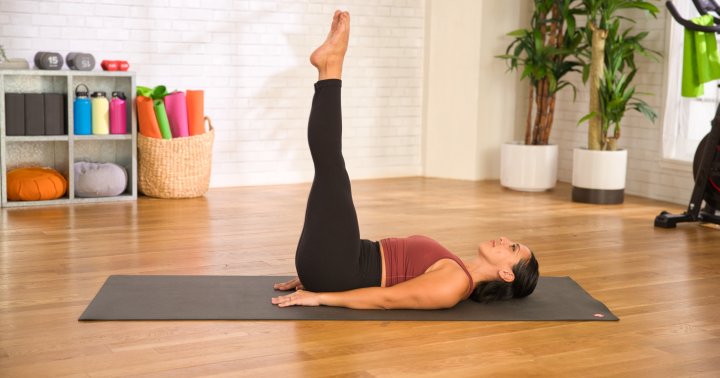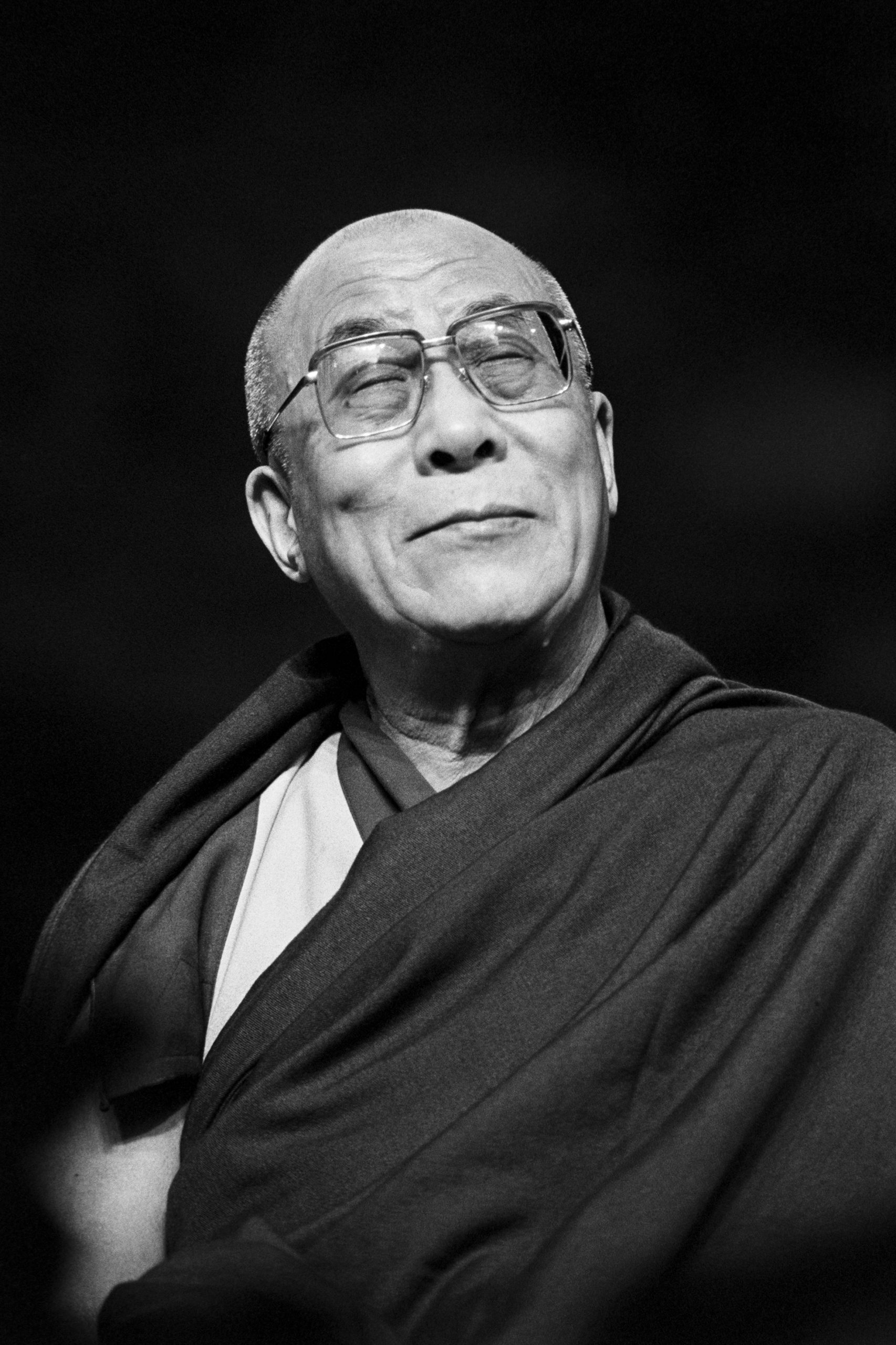Setu Bandha Sarvangasana: A Yogi’s Ultimate Guide to Bridge Pose
The post Setu Bandha Sarvangasana: A Yogi’s Ultimate Guide to Bridge Pose appeared first on The Yoga Nomads.
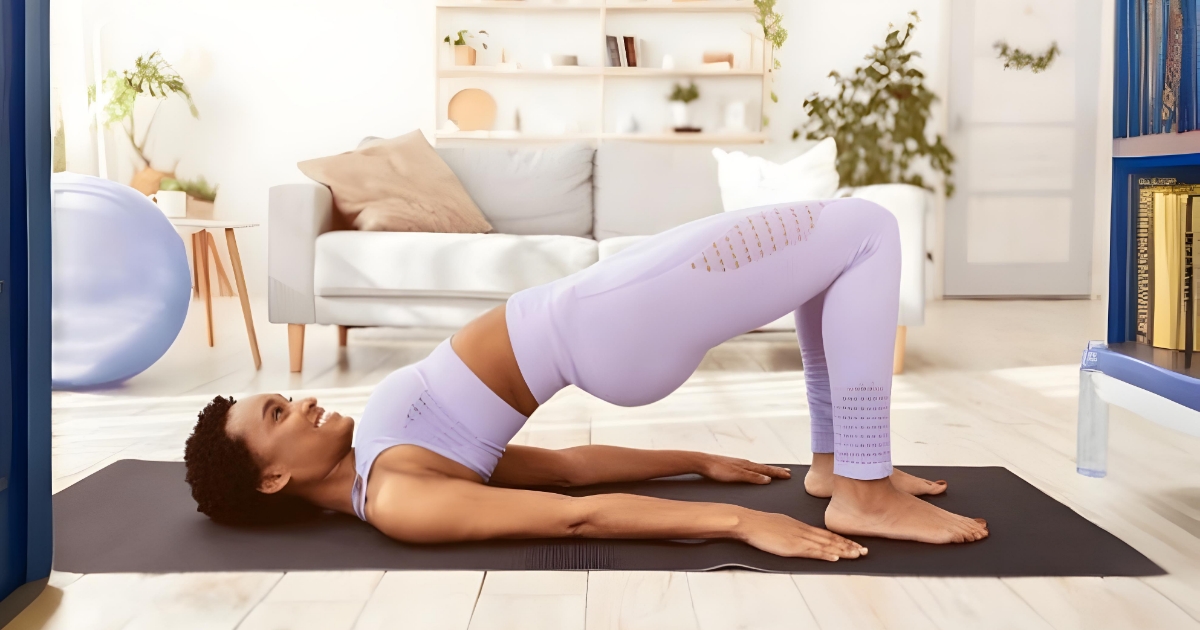
Key Takeaway
Setu Bandha Sarvangasana, commonly called Bridge Pose, is a foundational yoga asana that builds strength, reduces stress, and supports spinal health. Learn about the anatomy and alignment of the Bridge Pose, then explore modifications and variations to get the most out of this pose.
Within my yoga practice and teaching, I’ve found few yoga poses as universally beneficial and potent as Setu Bandha Sarvangasana or Bridge Pose. This asana holds a special place in my repertoire thanks to its versatility and the unique balance between relaxation and challenge.
This pose is not only accessible to practitioners of all levels but also serves multiple purposes — as a restorative posture to relieve a back ache, a strength-building pose to tone your muscles, and even functioning as an intense heart and shoulder opener when executed with precision.
Join me on a deep dive into getting to know Setu Bandha Sarvangasana, learning about this pose’s intricate structure and how it can enrich your yoga practice and everyday movement. Roll out your yoga mat, and let’s get started!
Watch our recommended steps for entering, holding, and exiting the pose.
Introduction to Bridge Pose
Before we dive into our practice tutorial, let’s take a moment to get acquainted with the basics of Setu Bandha Sarvangasana, commonly known as Bridge Pose.
Sanskrit Name
Sanskrit pose names can be intimidating to learn, especially when they’re as long as Setu Bandha Sarvangasana. But as a yoga instructor, I believe it’s important to share Sanskrit terminology out of respect for yoga’s tradition.
Setu Bandha Sarvangasana becomes easier to remember when broken down into parts:
Setu = “bridge,” representing the physical form of the pose Bandha = “lock,” referring to the “energy locks” or specific muscles you engage to control energy flow throughout the body Sarvanga = “whole body,” coming from the root words sarva (all) and anga (limb) Asana = “pose”When we put it together, we can understand the name of this asana as “Bridge Pose with Whole Body Lock.” This interpretation indicates that the three primary bandhas (root, abdominal, and throat) are all engaged.
Anatomy of the Pose
Although most teachers consider Bridge Pose a beginner-friendly asana, that doesn’t necessarily mean it’s easy! As the name Setu Bandha Sarvangasana implies, this yoga pose engages the whole body and includes many movement patterns simultaneously.
The spine extends as you lift into a backbend. Several muscles contract isometrically to hold your position and maintain balance. Meanwhile, the front body and hips receive a gentle stretch.This full-body engagement makes Bridge Pose a highly effective yoga pose, especially for beginning yoga students learning to coordinate their breathing and movement while building body awareness.
Step-by-Step Guide for Practicing Setu Bandha Sarvangasana
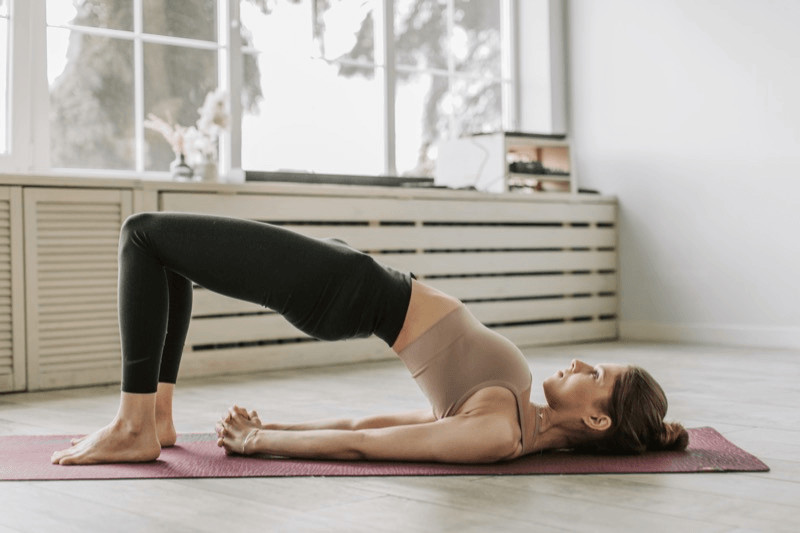
Now that you know what to expect in Setu Bandha Sarvangasana, you’re ready to try it yourself. Follow the guidance in this step-by-step tutorial to refine your form in Bridge Pose.
Starting Position
Lie flat on your back. Bend your legs and place your feet flat on the floor, separated at a hip-width distance with your toes pointing forward. Keep your legs parallel with your ankles, knees, and hips aligned. Bring your arms to your sides with your palms pressing into the floor.Engage and Lift
Take a breath in, and engage your abdominal muscles as you exhale. Press down firmly through the soles of your feet and your palms as your hips lift, creating an even curvature throughout your spine. Squeeze your glutes as you lift higher. Engage your hamstrings with an isometric contraction by drawing your heels back while keeping your feet firmly in place on your yoga mat. Tuck your chin toward your chest slightly and broaden your shoulder blades against the floor, allowing your chest to open. Keep breathing steadily.Shoulder-Opening Option
For a deeper backbend, squeeze your shoulder blades together, bringing your shoulders more underneath yourself. Bring your arms underneath your body and clasp your hands together, keeping your arms straight. Widen your collarbones and press your chest up as you continue to lift your hips. When you reach the full range of your Bridge Pose, hold for 5 to 10 breaths.For those seeking more of a challenge or a deeper backbend, clasp hands under your body. Then, press your shoulders into the mat firmly.
Release with Gentle Movement
When ready to release, take your time. If your fingers are interlaced beneath you, unclasp your hands and place them at your sides, palms on your mat. Lower your body down with ease, rolling through your spine one vertebra at a time. Rest with your back flat on your yoga mat for a few breaths, allowing your spine to return to a neutral position.You may repeat Setu Bandha Sarvangasana another time or two or move on to a counterpose or a deeper backbend.
Alignment Advice for Common Issues in Bridge Pose
Setu Bandha Sarvangasana has an intricate structure that requires attention to detail for safe practice. Follow this guidance to avoid common issues that may lead to injury in beginning students.
Ground evenly through the feet: Avoid rolling onto the outer edges of the feet and lifting the inner arches, as this can place strain on the ankles. Keep the thighs parallel: Letting the knees drop inward or splay out to the sides can cause joint pain and prevent proper muscle engagement. Hug your inner thighs toward your midline to keep your legs aligned. Use your arm strength: When holding the pose with your arms at your sides, press down through the entire length of each arm. This builds strength in your arm muscles and creates more stability and balance. Avoid turning your head: Gaze straight up to align your head and neck with your spine. Maintain length in the back of your neck by tucking your chin slightly.These anatomy awareness and alignment recommendations will help you enjoy the maximum benefits of Bridge Pose while preventing pain and the risk of injury.
Setu Bandha Sarvangasana Contraindications
While this yoga pose is typically appropriate for beginners, it might not be safe for people with specific health conditions. If you experience any of the following issues, it’s best to consult a medical practitioner and seek guidance from an experienced yoga instructor.
Chronic backache or spinal injury: Bridge Pose creates curvature in the spine, which may worsen your condition. Recent neck injury: The body’s position in this pose can cause discomfort. Recent abdominal surgery: This posture stretches the front body, so be sure you are fully recovered with a doctor’s clearance before attempting Bridge. Migraines, glaucoma, and high blood pressure: Symptoms may worsen as blood flow to the head increases. Osteopenia, osteoporosis, and issues with bones: Avoid intense spinal extension, which could lead to a compression fracture. 2nd or 3rd trimester of pregnancy: A large belly can affect balance and place strain on the lower back. Pregnant yoga students should follow the guidance of an experienced prenatal yoga instructor.Bridge pose Modifications and Variations
There are many ways to alter Setu Bandha Sarvangasana to make it work for every practitioner, supporting various ranges of mobility and strength. In my yoga classes, I encourage prop use and gentle movement with breath coordination to enhance my students’ Bridge Pose experience.
Support and Accessibility with Props
Blanket: Use a folded blanket under your neck and shoulders for added comfort while holding the pose. Yoga block: Try a supported version of Bridge Pose by placing a yoga block underneath the tailbone. You can achieve different grades of backbend support depending on the block’s orientation. Strap: If you want to work on opening your shoulders but cannot clasp your hands underneath yourself, use a yoga strap instead. Lay the strap underneath yourself and grip the strap with both hands as close together as possible.
lululemon’s Lift and Lengthen Yoga Block
Bridge Pose Variations for Strength
If you aim to practice Bridge Pose in a strength-building yoga class, explore these variations. Subtle changes in body position can make a big difference in muscle engagement!
Lift one leg at a time to challenge your balance and strengthen your leg muscles. Squeeze a yoga block between your thighs to engage the inner thigh muscles and maintain alignment. Use a modified Bridge position: move your feet slightly in front of your knees rather than directly underneath. Lengthening your stance shifts more of the work to your hamstrings. Try a dynamic version, coordinating your breathing and movement. Lift your hips into Bridge pose as you inhale. With your exhale, lower down. Continue this gentle movement for several breaths, mobilizing your spine and warming up your whole body.These variations introduce various ranges of movement and foster a deeper awareness of muscle engagement across different body parts.
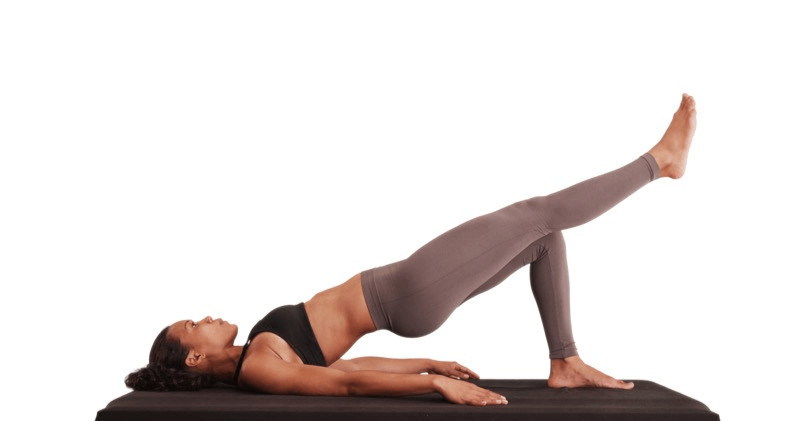
Recommendations for Incorporating Setu Bandha Sarvangasana into Your Yoga Practice
Uses in a Yoga Class
Integrating Setu Bandha Sarvangasana into your yoga practice supports spinal health and everyday movement. When teaching a yoga class, I love to incorporate Bridge Pose in many ways.
To practice breath awareness paired with dynamic movement To gently stretch and mobilize the spine as a warm-up for deeper backbends To activate the core muscles in a strength or balance-focused class. As a counterpose to forward folds like Downward Dog and Seated Forward Bend.In my experience, practicing this pose dynamically with breath at the start of class helps me focus on good breathing practices and clears my mind of any lingering distractions.
Preparatory Poses for Setu Bandha Sarvangasana
Whether teaching or practicing on my own, I always start with some gentle movement to warm up the spine before lifting into Bridge Pose. Here are my top recommendations for Setu Bandha Sarvangasana warm-ups.
Pelvic Tilts: Lie on your back with your knees bent and feet planted at a hip-width distance. Tilt your pelvis forward and down as you inhale so your lower back arches off the floor. Then, exhale and rock your pelvis the other way, tucking your tailbone and pressing your lower back into your mat. Keep breathing and continue this movement for a minute or so. Windshield Wipers: Begin in the same starting position with your knees bent and feet flat. In a “windshield wiper” movement, gently drop your knees from side to side. Move with ease, following the pace of your breathing.Counter Poses
Setu Bandha Sarvangasana engages the back muscles, so you may need to release some tension after a few rounds of Bridge Pose. These yoga poses provide a gentle stretch for your back and help restore balance in your spine after being in an arched position.
Happy Baby: Bring your knees toward your chest and grasp your ankles. Open your legs wider than your torso and flex your feet with the soles facing upward. Keep your shoulders grounded and each your pelvis forward and down to maintain the natural curvature of your spine. Supine Twist: Lie on your back and bend one leg, bringing your knee toward your chest. As you exhale, bring your bent leg across your body in a twist. Hold for a few breaths, then return to your starting position and repeat your twist on the other side.Benefits of Setu Bandha Sarvangasana
What I love most about Bridge Pose as a yoga instructor is how it supports overall mobility. Everyday movement requires core strength to maintain balance and a healthy spine capable of many movement patterns.
Besides being fantastic for mobility and strength, Setu Bandha Sarvangasana contributes to overall well-being in many ways.
Supports spinal health: Backbends lengthen the spine, which can help relieve back pain and stiffness. Builds body strength: This pose strengthens and tones the back, hamstrings, glutes, and abdominal muscles. Increases flexibility and range of motion: Besides giving your spine a good stretch, this pose also lengthens your front body, hip flexors, and quadriceps while opening your chest and shoulders. Supports good posture: As a heart-opener, Bridge Pose is a great way to undo the effects of sitting in a slouched position with rounded shoulders. Releases stress: Setu Bandha Sarvangasana has a grounding effect on the body and brings awareness to your breathing while quieting the mind. Energizes the body: Bridge Pose can be relaxing when used in a restorative way. But it can energize your body, too, stimulating blood flow when moving dynamically.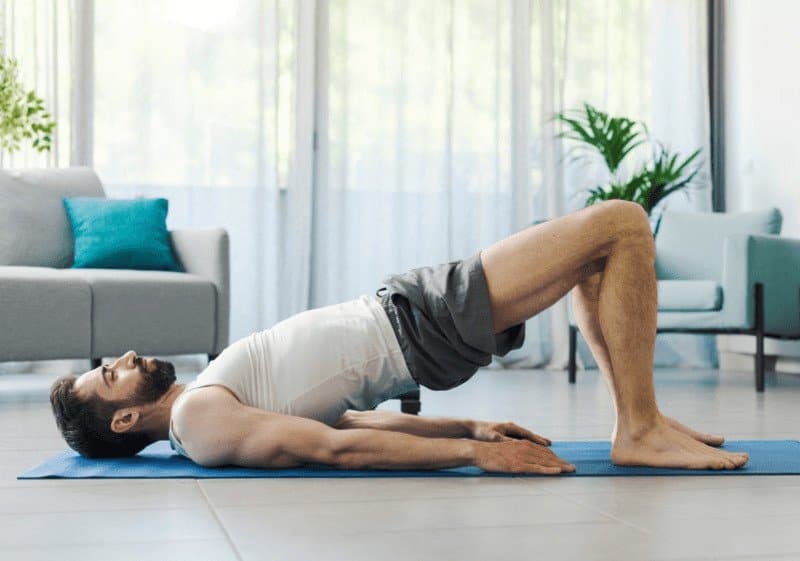
Closing Thoughts
With its ability to ease tension, improve spinal health, and promote good posture, Bridge Pose stands out as a cornerstone in any yoga practice. By incorporating Setu Bandha Sarvangasana into your routine, you not only support many aspects of your physical health but unlock a pathway to greater ease in movement.
My advice is to approach the pose with mindfulness and awareness, honoring your body’s unique needs and limitations while exploring the full range of motion it offers. For seasoned yogis and beginning yoga students alike, Setu Bandha Sarvangasana becomes a trusted ally on your path to strength, balance, flexibility, and overall well-being.
Pop quiz! 🧘🤔
Yoga teachers consider Setu Bandha Sarvangasana an advanced yoga pose.
Setu Bandha Sarvangasana can be either restorative or strength-building.
Setu Bandha Sarvangasana can improve back health and posture.
Frequently Asked Questions
What is Setu Bandha Sarvangasana?
Setu Bandha Sarvangasana, also known as Bridge Pose, is a yoga pose that strengthens the back, opens the chest and shoulders, and enhances flexibility in the spine.
How can practicing Bridge Pose benefit overall well-being?
Bridge Pose helps improve spinal flexibility, strengthens several key muscle groups, reduces stress, and energizes the body.
Can I modify Bridge Pose with props?
Yes. To make Bridge Pose more accessible or comfortable, use a block under your sacrum for support or a blanket under your shoulders for extra cushion.
What are the contraindications for Setu Bandha Sarvangasana?
Individuals with neck injuries, chronic back pain, high blood pressure, recurring migraines, or issues in the bones (osteopenia) should consult a medical practitioner before trying this yoga pose.
What are some recommendations for incorporating Setu Bandha Sarvangasana into my daily yoga practice?
Setu Bandha Sarvangasana complements many movement patterns and works well with various yoga poses. Try using it to build lower body strength, to warm up for deeper backbends, or as a counterpose to forward folds.
Thanks for your feedback!

 UsenB
UsenB 







